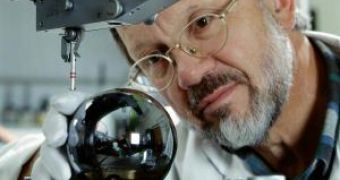A mathematical definition of the sphere says it is a perfectly symmetrical geometrical object, the set of all points in three-dimensional space which are at the same distance from a fixed point in space. The problem is that on the nanoscale, there is no such thing as a perfect sphere.
The ideal sphere will touch a flat surface in exactly one point, which is currently impossible to achieve. But a team of Australian scientists and optical engineers are working on constructing such a perfect sphere, that may one day re-define the kilogram.
Since 1889, the SI system defines the unit to be equal to the mass of the international prototype of the kilogram, which is made from an alloy of 90% platinum and 10% iridium (by weight) and machined into a right-circular cylinder (height = diameter) of 39 mm.
There is one problem here, the fact that the international prototype of the kilogram seems to have lost about 50 micrograms in the last 100 years and the reason for the loss is still unknown.
This is why the search for a new definition of the kilogram, under the auspices of the International Bureau of Weights and Measures (BIPM), near Paris. The international effort will be made with the close cooperation of Australia's National Measurement Institute (NMI) and CSIRO's Australian Centre for Precision Optics (ACPO).
"The only people who can make what is likely to be the roundest object in the world are our colleagues at CSIRO's ACPO," Dr Barry Inglis, Chief Executive of NMI says. The team succeeded so far in making a sphere with a total out-of-roundness of 35 nanometres, meaning that the diameter only varies by an average of only 35 millionths of a millimeter, making it probably the roundest object in the world.

 14 DAY TRIAL //
14 DAY TRIAL //